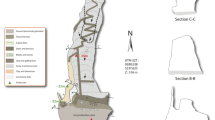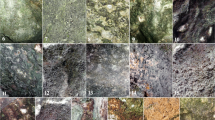Abstract
No information exists on phototrophs growing on the stone surfaces of the Catacombs of SS. Marcellino and Pietro (the site was only recently opened to the public in 2014). Therefore, it was decided to characterise the microbial communities and to compare them with those of the other previously studied catacombs. Moreover, a new non-invasive strategy to reduce the phototrophic growth was tested. Phototrophic microorganisms were investigated under light and confocal laser scanning microscopes from samples collected non-invasively in situ. Tests were carried out to determine the effect of the application of two essential oils (from L. angustifolia and T. vulgaris) on biofilm photosynthetic activity. Laser-induced fluorescence (LIF) and reflectance measurements in the visible range have been used to evaluate respectively, any chemical modification and discolouration on a frescoed stone that may occur after the application of the essential oils. At all the concentrations of essential oils, there was a quasi-immediate, large reduction in photosynthetic activity of the biofilms. At 10% essential oil concentration, there was no detectable photosynthetic activity after 15 min. At 1%, there was a need for two applications and after 5-day activity was undetectable. No effect of the essential oils on the substrate surface properties or colour modification of the fresco has been observed with the LIF prototype. Cyanobacterial typical of Roman catacombs were present in the sites investigated. Innovative and non-destructive strategies, involving the application of a combination of two essential oils, have been successfully tested and developed to prevent biodeterioration of these sites.






Similar content being viewed by others
References
Albertano P (2012) Cyanobacterial biofilms in monuments and caves. In: Whitton (ed) Ecology of cyanobacteria II: their diversity in space and time. Springer, Netherlands, pp 317–343
Albertano P, Bruno L (2003) The importance of light in the conservation of hypogean monuments. In: Saiz-Jimenez (ed) Molecular biology and cultural heritage. Swets & Zeitlinger, Lisse, pp 171–177 ISBN 90 5809 555X
Albertano P, Pacchiani D, Capucci E (2004) The public response to innovative strategies for the control of biodeterioration in archaeological hypogea. J Cult Herit 5(4:399–407
Albertano P, Bruno L, Bellezza S (2005) New strategy for the monitoring and control of cyanobacterial films on valuable lithic faces. Plant Biosyst 139:311–322
Barresi G, Cammarata M, Palla F (2017) Biocide. In: Palla F, Barresi G (eds) Biotechnology and conservation of cultural heritage. https://doi.org/10.1007/978-3-319-46168-7_3
Bilger W, Schreiber U, Bock M (1995) Determination of the quantum efficiency of photosystem II and of non-photochemical quenching of chlorophyll fluorescence in the field. Oecologia 102:425–432
Bruno L, Billi D, Bellezza S, Albertano P (2009) Cytomorphological and genetic characterization of troglophilic Leptolyngbya strains isolated from Roman hypogea. Appl Environ Microbiol 75:608–617
Bruno L, Bellezza S, De Leo F, Urzi C (2014a) A study for monitoring and conservation in the Roman catacombs of St. Callistus and Domitilla, Rome (Italy). In: Saiz-Jimenez (ed) The conservation of subterranean cultural heritage. CRC Press, pp 37–44 Chapter 5, ISBN 978-1-138-02694-0
Bruno L, Ficorella I, Valentini F, Quici L, Keshari N, Adhikary SP (2014b) Characterization of phototrophic biofilms deteriorating Indian stone monuments, their response to heat stress and development of a non-invasive remediation strategy. In: Rogerio-Candelera MA (ed) Science, technology and cultural heritage. CRC Press/Balkema, The Netherlands, pp 205–210 ISBN 978-1-138-02744-2
Bruno L, Quici L, Ficorella I, Valentini F (2014c) NanoGraphene oxide: a new material for a non-invasive and non-destructive strategy to remove biofilms from rock surfaces. In: Saiz-Jimenez C (ed) The conservation of subterranean cultural heritage. CRC Press, Taylor & Francis Group, London, pp 125–130, ISBN 978–1–138-02694-0. https://doi.org/10.1201/b17570-17s2.0-84958762820
Bruno L, Valle V (2017) Effect of white and monochromatic lights on cyanobacteria and biofilms from Roman Catacombs. Int Biodeter Biodegr 123:286-295
Bruno L, Valle V, Gismondi A, Di Marco G, Canini A (2018) Applicazione di oli essenziali come metodo non-invasivo per il controllo del biodeterioramento di beni culturali in pietra. Notiz Soc Bot Ital 2:6–7
Castenholz RW (2001) Phylum BX. Cyanobacteria. Oxygenic photosynthetic bacteria. In: Boone DR, Castenholz RW, Garrity GM (eds) Bergey’s manual of systematic bacteriology, vol 1, 2nd edn. Springer, New York, pp 473–487
Chelius MK, Beresford G, Horton H, Quirk M, Selby G, Simpson RT, Horrocks R, Moore JC (2009) Impacts of alterations of organic inputs on the bacterial community within the sediments of wind cave, South Dakota, USA. Int J Speleol 38:1–10
Fernandes C, Barros S, Galhano V, Geraldes AM (2014) Searching for algaecide or algaestatic effects of several plant extracts on phytoplankton: preliminary results. Br Biotechnol J 4(10):1077–1087
Giovannini D, Gismondi A, Basso L, Canuti L, Braglia R, Canini A, Mariani F, Cappelli G (2016) Lavandula angustifolia Mill. Essential oil exerts antibacterial and anti-inflammatory effect in macrophage mediated immune response to Staphylococcus aureus. Immunol Investig 45(1):11–28
Guiamet PS, de la Paz NJ, Arenas PM, Gómez de Saravia SG (2008) Differential sensitivity of Bacillus sp. isolated from archive materials to plant extracts. Pharmacologyonline 3:649–658
Hernández-Máriné M, Clavero E, Roldán M (2003) Why there is such luxurious growth in the hypogean environments. Algol Stud 109(1):229–239
Hsieh P, Pedersen JZ, Bruno L (2014) Photoinhibition of cyanobacteria and its application in cultural heritage conservation. Photochem Photobiol 90:533–543
Kim AR, Kim HS, Park SO (2011) Measuring of the perceptibility and acceptability in various color quality measures. J Opt Soc Korea 15(3):310–317
Krakova L, De Leo F, Bruno L, Pangallo D, Urzì C (2015) Complex bacterial diversity in the white biofilms of St. Callistus catacombs in Rome evidenced by different investigation strategies. Environ Microbiol 17(5):1738–1752
Mann CM, Markham JL (1998) A new method for determining the minimum inhibitory concentration of essential oils. J Appl Microbiol 84:538–544
Marshall WA, Chalmers MO (1997) Airborne dispersal of Antarctic terrestrial algae and cyanobacteria. Ecography 20(6):585–594
Martinez JR, Nieto-Villena A, de la Cruz-Mendoza JA, Ortega-Zarzosa G, Guerrero AL (2017) Monitoring the natural aging degradation of paper by fluorescence. J Cult Herit 26:22–27. https://doi.org/10.1016/j.culher.2017.01.011
Moghimi R, Aliahmadi A, Rafati H (2017) Antibacterial hydroxypropyl methyl cellulose edible films containing nanoemulsions of Thymus daenensis essential oil for food packaging. Carbohydr Polym 175:241–248
Nevin A, Spoto G, Anglos D (2012) Laser spectroscopies for elemental and molecular analysis in art and archeology. Appl Phys A Mater Sci Process 106(2):339–361
Palombi L, Alderighi D, Cecchi G, Raimondi V, Toci G, Lognoli D (2013) A fluorescence LIDAR sensor for hyper-spectral time-resolved remote sensing and mapping. Opt Express 21:14737–14746
Pozo-Antonio JS, Montojo C, Lopez de Silanes ME, de Rosario I, Rivas T (2017) In situ evaluation by colour spectrophotometry of cleaning and protective treatments in granitic cultural heritage. Int Biodeterior Biodegrad 123:251–261
Puškárová A, Bučková M, Kraková, Pangallo D, Kozics K (2017) The antibacterial and antifungal activity of six essential oils and their cyto/genotoxicity to human HEL 12469 cells. Sci Rep 7(8211):1–11
Rippka R, Deruelles J, Waterbury B, Herdman M, Stanier R (1979) Generic assignments, strains histories and properties of pure cultures of cyanobacteria. J Gen Microbiol 111:1–61
Ruffolo SA, De Leo F, Ricca M, Arcudi A, Silvestri C, Bruno L, Urzì C, La Russa MF (2017) Medium-term in situ experiment by using organic biocides and titanium dioxide for the mitigation of microbial colonization on stone surfaces. Int Biodeterior Biodegrad 123:17–26
Saiz-Jimenez C, Cuezva S, Jurado V, Fernandez-Cortes A, Porca E, Benevante D, Cañaveras JC, Sanchez-Moral S (2011) Paleolithic art in peril: policy and science collide at Altamira Cave. Science 334:42–43
Sanchez-Moral S, Luque S, Cuezva S, Soler V, Benavente D, Laiz L, Gonzàlez JM, Saiz-Jimenez C (2005) Deterioration of building materials in Roman catacombs: the influence of visitors. Sci Total Environ 349:260–276
Sanchez-Moral S, Cañaveras JC, Benavente D, Fernandez-Cortes A, Cuezva S, Elez J, Jurado V, Rogerio-Candelera MA, Saiz-Jimenez C (2018) A study in the state of conservation of the Roman Necropolis of Carmona (Sevilla, Spain). J Cult Herit 34:185–197
Sanmartín P, Villa F, Polo A, Silva B, Prieto B, Cappitelli F (2015) Rapid evaluation of three biocide treatments against the cyanobacterium Nostoc sp. PCC 9104 by color changes. Ann Microbiol 2–65
Sanmartín P, De Araujo A, Vasanthakumar A (2018) Melding the old with the new: trends in methods used to identify, monitor and control microorganisms on cultural heritage materials. Microb Ecol 76:64–80
Sasso S, Miller AZ, Rogerio-Candelera MA, Cubero B, Coutinho ML, Scrano L, Bufo SA (2016) Potential of natural biocides for biocontrolling phototrophic colonization on limestone. Int Biodeterior Biodegrad 107:102–110
Schreiber U, Bilger W (1993) Progress in chlorophyll fluorescence research: major developments during the past years in retrospect. Prog Bot 54:151–173
Spizzichino V, Angelini F, Caneve L, Colao F, Corrias R, Ruggiero L (2015) In situ study of modern synthetic materials and pigments in contemporary paintings by laser-induced fluorescence scanning. Stud Conserv 60(1):178–184
Stupar M, Grbić MLJ, Džamić A, Unković N, Ristić M, Jelikić A, Vukojević J (2014) Antifungal activity of selected essential oils and biocide benzalkonium chloride against the fungi isolated from cultural heritage objects. S Afr J Bot 93:118–124
Targowski P, Walczak M, Pouli P (2017) Lasers in the Conservation of Artworks XI. In: Targowski P, Walczak M, Pouli P (eds) Proceedings of the International Conference LACONA XI, Kraków, Poland, 20–23 September 2016, NCU Press, Toruń. https://doi.org/10.12775/3875-4
Toreno G, Isola D, Meloni P, Carcangiu G, Selbmann L, Onofri S, Caneva G, Zucconi L (2018) Biological colonization on stone monuments: a new low impact cleaning method. J Cult Herit 30:100–109
UNI EN 15886 (2010) Conservation of cultural property—test methods—colour measurement of surfaces. UNI Ente Nazionale Italiano di Unificazione
Urzì C, De Leo F (2001) Sampling with adhesive tape strips: an easy and rapid method to monitor microbial colonization on monument surfaces. J Microbiol Methods (44):1–11
Urzì C, De Leo F, Bruno L, Albertano P (2010) Microbial diversity in Paleolithic Caves: a study case on the phototrophic biofilms of the cave of bats (Zuheros, Spain). Microb Ecol 60:116–129
Urzì C, De Leo F, Bruno L, Pangallo D, Krakova L (2014) New species description, biomineralization processes and biocleaning applications of Roman catacombs-living bacteria. In: Saiz-Jimenez C (ed) The conservation of subterranean cultural heritage. CRC Press, Taylor & Francis Group, London, pp 65–72, ISBN 978-1-138-02694-0. https://doi.org/10.1201/b17570-10
Urzì C, De Leo F, Krakova L, Pangallo D, Bruno L (2016) Effects of biocide treatments on the biofilm community in Domitilla’s catacombs in Rome. Sci Total Environ 572(1):252–262
Zammit G, Billi D, Albertano P (2012) The subaerophytic cyanobacterium Oculatella subterranea (Oscillatoriales, Cyanophyceae) gen. et sp. nov.: a cytomorphological and molecular description. Eur J Phycol 47(4):341–354
Acknowledgments
The authors thank the ‘Pontificia Commissione of Archeologia Sacra’ for the permission to investigate the Catacombs of SS. Marcellino and Pietro and the centre ‘CMA-P Albertano’ for the use of the CLSM.
Funding
The work was partially funded by the project ADAMO in the frame of DTC (Technological District for Cultural Heritage) Lazio Det.reg. G08622.
Author information
Authors and Affiliations
Corresponding author
Ethics declarations
Conflict of interest
The authors declare that they have no conflict of interest.
Research involving human participants and/or animals
No humans or animals were used in this work.
Informed consent
N/A
Additional information
Publisher’s note
Springer Nature remains neutral with regard to jurisdictional claims in published maps and institutional affiliations.
Rights and permissions
About this article
Cite this article
Bruno, L., Rugnini, L., Spizzichino, V. et al. Biodeterioration of Roman hypogea: the case study of the Catacombs of SS. Marcellino and Pietro (Rome, Italy). Ann Microbiol 69, 1023–1032 (2019). https://doi.org/10.1007/s13213-019-01460-z
Received:
Accepted:
Published:
Issue Date:
DOI: https://doi.org/10.1007/s13213-019-01460-z




